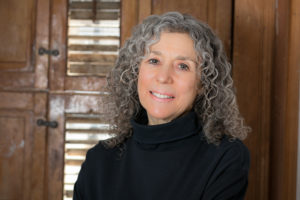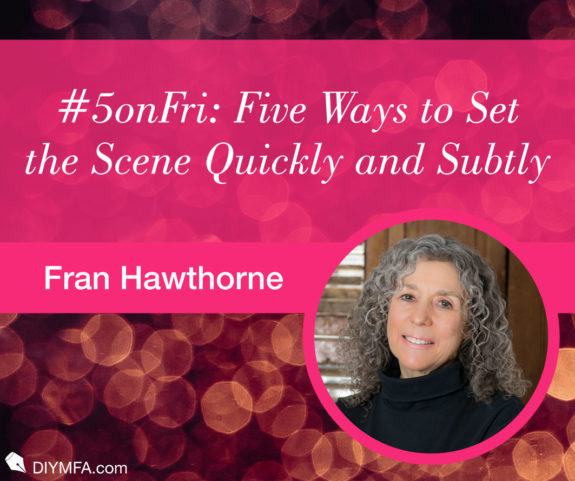Fiction isn’t journalism, of course. You don’t need to cram all five Ws (who, what, when, where, and why) into the opening paragraph of your novel or short story. Still, if you’re writing mainstream fiction, your readers ought to be able to establish some bearings early in the narrative. You need to set the scene.
Most writers get to the “who,” “what,” and “when” easily enough, since a story can’t have much action without those elements. Nor is “why” a big problem; the plot will take its own time exploring that question.
“Where,” however, can seem less urgent, except maybe if it’s an exotic locale or crucial to the plot. Too often, it’s inserted almost as a clumsy afterthought:
“I can’t take another winter here in Buffalo!” Jill thought.
“Why did you move to Dallas?” Jack asked Jill.
In real life, people don’t think or talk that way. We know what city we’re in, so we don’t announce it to ourselves. If Jack and Jill are friends before the story begins, she’s probably already told him how she ended up in Dallas.
But the initial scene-setting doesn’t have to be complicated. You don’t have to name the exact site immediately. You only have to give the reader a basic idea of what to expect. Beach resort? Desert? Booming city? Small farm? It can be a simple phrase, even a noun or adjective.
Here are five possible strategies to get you started:
1. Clothing equals geography plus season
Originally, my newest novel began with a fight between an engaged couple, Russ and Miranda, in their apartment just before dinner. Because it was inside their home, I didn’t see any unobtrusive way to situate them in place or time (which happened to be Washington DC in December 2002).
“Is Russ wearing a coat when he walks into the apartment?” my teacher at a writers’ workshop, Sean Prentiss, asked.
Sure: Russ is wearing an expensive wool coat with ketchup stains on one sleeve… And with that, in less than a sentence, I’d established some clues about the book’s setting (a locale with apartment buildings and a cold season) as well as Russ’s income level, eating habits, and sloppiness.
People strap on sandals, pull off raincoats, and hug sweaters around their shoulders all the time. Not only are these hints about the setting, but they’re also great ways to break up dialogue.
2. Make it part of the action
Unless you’re aiming for a mood of deep isolation or claustrophobia, you probably don’t want an entire novel set in someone’s bedroom. Well then, if your characters are going to be out and about anyway, why not send them to vivid spots that are particular to their geographic location?
They can take the kids to a Cubs game—not just any baseball game—or arrange a business dinner in the elegant Porter House restaurant overlooking Manhattan’s Central Park. If someone is an urban planner, she’s working on the Three Rivers trail in Pittsburgh. If he’s super-rich, he’ll pick up a necktie at a boutique on Rodeo Drive in Los Angeles.
Are guests visiting from out of town? Your characters can show them a famous local tourist site. To make the visit more interesting, research an unusual quirk or two about that site.
3. Eat it up!
With Chinese, Italian, Indian, Japanese, and Middle Eastern restaurants available in just about any fair-sized U.S. or European municipality, meals are a less useful indicator of setting than they once were. Your characters’ eating habits probably say more about where their families came from, than where they live now.
Still, cuisine can be a marker, perhaps by comparison. Maybe your protagonist is thrilled that her little town in Nebraska finally got a good bagel place. Maybe your location has the best Thai food within 100 miles of Phoenix.
4. The details can wait
If you hate writing descriptions, don’t worry; you can continue planting small factual clues like these throughout the rest of your narrative.
On the other hand, if you love writing descriptions, go for it—but not too much, and not too soon. As a general rule, it’s usually plot or character, not description, that hooks the reader.
5. It’s okay to use crutches… carefully
Instead of the fight-in-the-apartment scene that I mentioned earlier, the published version of my newest novel begins with a prologue, topped by the heading:
April 13, 1996; Interstate 495, en route to Washington Dulles International Airport
What? That would sure seem to violate all of my own advice.
Call it “the prologue exception.” With a prologue, epilogue, or long flashback, you may want to make clear that what follows is, in essence, a world unto itself, set in a time and place totally different from the rest of the book. I think that’s fine, but like any writing technique, it loses its potency if overused.
P.S. Going back to one of my earlier examples, if Jack and Jill are meeting for the first time in Chapter One, then sure, he might reasonably ask why she moved to Dallas.
Remember that there’s more to your setting than you might think: topography, geology, climate, smells, sounds, history, economics, and demographics. You’ve got a lot to work with!

Fran Hawthorne started writing novels at the age of four, although she was sidetracked for a few decades by journalism. Her award-winning nonfiction books are mainly about consumer activism, the drug industry, and finance; she’s also been an editor or regular contributor for Fortune magazine, The New York Times, and many other publications. But Fran never abandoned her true love: I Meant to Tell You (Stephen F. Austin State University Press, November 2022) is her second published novel. You can find out more from her website and follow her on Twitter, and Instagram.







